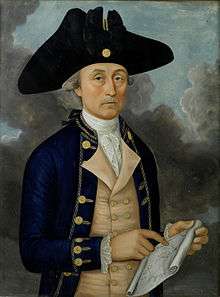Reverse glass painting
Reverse painting on glass is an art form consisting of applying paint to a piece of glass and then viewing the image by turning the glass over and looking through the glass at the image. Another term used to refer to the art of cold painting and gilding on the back of glass is verre églomisé, named after the French decorator Jean-Baptiste Glomy (1711–86), who framed prints using glass that had been reverse-painted.[1] In German it is known as Hinterglasmalerei.

This art form has been around for many years. It was widely used for sacral paintings since the Middle Ages. The most famous was the art of icons in the Byzantine Empire. Later the painting on glass spread to Italy, where in Venice it influenced its Renaissance art. Since the middle of the 18th century, painting on glass became favored by the Church and the nobility throughout Central Europe. A number of clock faces were created using this technique in the early-to-mid-19th century. Throughout the 19th century painting on glass was widely popular as folk art in Austria, Bavaria, Moravia, Bohemia and Slovakia. Unfortunately, during the inter-war period (1914–1945) this traditional "naive" technique fell nearly to a complete oblivion and its methods of paint composition and structural layout had to be re-invented by combining acrylic and oil paints. A new method of reverse painting emerged using polymer glazing methods that permitted the artworks to be painted direct to an acrylic UV coating on the glass. The unique under glass effect retains a curious depth even though the layered painting on the glass was bonded to a final linen support and now stretcher bar mounted after being carefully removed from the original 'glass easel'. Current glass painting may disappear with the advent of using aerospace mylar as a preliminary support.
This style of painting is found in traditional Romanian icons originating from Transylvania. Jesuit missionaries brought it to China[2], and it spread to Japan from China during the Edo period. Japanese artists took up the technique during the nineteenth century.[3] Reverse glass painting was also popular in India[4] and Senegal[5] in the nineteenth century.
Reverse glass painting in the United States
Two American artists, Marsden Hartley and Rebecca Salsbury James, made artworks using reverse glass painting. Both were inspired by American folk art that included painting on glass, for instance, tinsel painting.[6]
Hartley's work in this medium began in 1917. He painted about a dozen still lifes of curvilinear vessels with flowers using this method, but after his initial enthusiasm, he gave up reverse glass painting in less than a year.
James began reverse painting in 1928, after Hartley introduced her to the technique.[7] Over the next three decades, she created some 200 floral still lifes, desert landscapes, and non-objective portraits in this medium.
References
- Michelle A. Erhardt and Amy M. Morris, Mary Magdalene, Iconographic Studies from the Middle Ages to the Baroque (Brill, 2012; ISBN 9004231951), p. 315.
- "Rise & Fall of the Canton Trade System". Visualizing Cultures. MIT. Retrieved 27 October 2019.
- Yamauchi, Yuki. "Reverse Paintings on Glass: The 200 Years of Dazzling History". The Japan Times. Retrieved 27 October 2019.
- Dallapiccola, Anna (2017). Reverse glass painting in India. New Delhi, India: Niyogi Books. ISBN 978-9385285349.
- Bouttiaux, FirstName (1994). Senegal behind glass : images of religious and daily life. Munich New York: Prestel, in association with the Royal Museum of Central Africa, Tervuren. ISBN 3791314246.
- Wurzelbacher, Karli (2017). "19th-Century Tinsel Painting Meets Modernism". Journal of Glass Studies. 59: 429–434. JSTOR 90013845.
- Marler, Regina (7 November 2019). "Al & Georgia & Beck & Paul". New York Review of Books. 66 (17): 10. Retrieved 27 October 2019.
 George Huszar creating an Icon
George Huszar creating an Icon „Saint Anne teaches Mary“, Austrian folk painting, early 19th century
„Saint Anne teaches Mary“, Austrian folk painting, early 19th century
| Wikimedia Commons has media related to Reverse painting on glass. |